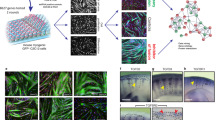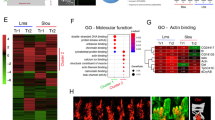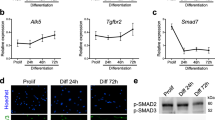Abstract
Skeletal muscles arise by fusion of precursor cells, myoblasts, into multinucleated fibers. In vertebrates, mechanisms controlling this essential step in myogenesis remain poorly understood1,2. Here we provide evidence that Kirrel, a homolog of receptor proteins that organize myoblast fusion in Drosophila melanogaster3,4, is necessary for muscle precursor fusion in zebrafish. Within developing somites, Kirrel expression localized to membranes of fusion-competent myoblasts of the fast-twitch lineage. Unlike wild-type myoblasts that form spatially arrayed syncytial (multinucleated) fast myofibers, those deficient in Kirrel showed a significant reduction in fusion capacity. Inhibition of Rac, a GTPase and the most downstream intracellular transducer of the fusion signal in D. melanogaster1,5,6, also compromised fast-muscle precursor fusion in zebrafish. However, unlike in D. melanogaster6, constitutive Rac activation in zebrafish led to hyperfused giant syncytia, highlighting an entirely new function for this protein in zebrafish for gating the number and polarity of fusion events. These findings uncover a substantial degree of evolutionary conservation in the genetic regulation of myoblast fusion.
This is a preview of subscription content, access via your institution
Access options
Subscribe to this journal
Receive 12 print issues and online access
$209.00 per year
only $17.42 per issue
Buy this article
- Purchase on Springer Link
- Instant access to full article PDF
Prices may be subject to local taxes which are calculated during checkout





Similar content being viewed by others
Accession codes
References
Chen, E.H. & Olson, E.N. Towards a molecular pathway for myoblast fusion in Drosophila . Trends Cell Biol. 14, 452–460 (2004).
Horsley, V. & Pavlath, G.K. Forming a multinucleated cell: molecules that regulate myoblast fusion. Cells Tissues Organs 176, 67–78 (2004).
Ruiz-Gomez, M., Coutts, N., Price, A., Taylor, M.V. & Bate, M. Drosophila dumbfounded: a myoblast attractant essential for fusion. Cell 102, 189–198 (2000).
Strunkelnberg, M. et al. rst and its paralogue kirre act redundantly during embryonic muscle development in Drosophila . Development 128, 4229–4239 (2001).
Hakeda-Suzuki, S. et al. Rac function and regulation during Drosophila development. Nature 416, 438–442 (2002).
Luo, L., Liao, Y.J., Jan, L.Y. & Jan, Y.N. Distinct morphogenetic functions of similar small GTPases: Drosophila Drac1 is involved in axonal outgrowth and myoblast fusion. Genes Dev. 8, 1787–1802 (1994).
Taylor, M.V. Muscle differentiation: how two cells become one. Curr. Biol. 12, R224–R228 (2002).
Baxendale, S. et al. The B-cell maturation factor Blimp-1 specifies vertebrate slow-twitch muscle fiber identity in response to Hedgehog signaling. Nat. Genet. 36, 88–93 (2004).
Blagden, C.S., Currie, P.D., Ingham, P.W. & Hughes, S.M. Notochord induction of zebrafish slow muscle mediated by Sonic hedgehog. Genes Dev. 11, 2163–2175 (1997).
Devoto, S.H., Melancon, E., Eisen, J.S. & Westerfield, M. Identification of separate slow and fast muscle precursor cells in vivo, prior to somite formation. Development 122, 3371–3380 (1996).
Du, S.J., Devoto, S.H., Westerfield, M. & Moon, R.T. Positive and negative regulation of muscle cell identity by members of the hedgehog and TGF-beta gene families. J. Cell Biol. 139, 145–156 (1997).
Roy, S., Wolff, C. & Ingham, P.W. The u-boot mutation identifies a Hedgehog-regulated myogenic switch for fiber-type diversification in the zebrafish embryo. Genes Dev. 15, 1563–1576 (2001).
Sellin, L. et al. NEPH1 defines a novel family of podocin interacting proteins. FASEB J. 17, 115–117 (2003).
Sun, C. et al. Kirrel2, a novel immunoglobulin superfamily gene expressed primarily in beta cells of the pancreatic islets. Genomics 82, 130–142 (2003).
Ueno, H. et al. A stromal cell-derived membrane protein that supports hematopoietic stem cells. Nat. Immunol. 4, 457–463 (2003).
Mann, C.J., Hinits, Y. & Hughes, S.M. Comparison of neurolin (ALCAM) and neurolin-like cell adhesion molecule (NLCAM) expression in zebrafish. Gene Expr. Patterns 6, 952–963 (2006).
Dan-Goor, M., Silberstein, L., Kessel, M. & Muhlrad, A. Localization of epitopes and functional effects of two novel monoclonal antibodies against skeletal muscle myosin. J. Muscle Res. Cell Motil. 11, 216–226 (1990).
Weinberg, E.S. et al. Developmental regulation of zebrafish MyoD in wild-type, no tail and spadetail embryos. Development 122, 271–280 (1996).
Gardahaut, M.F., Fontaine-Perus, J., Rouaud, T., Bandman, E. & Ferrand, R. Developmental modulation of myosin expression by thyroid hormone in avian skeletal muscle. Development 115, 1121–1131 (1992).
Bour, B.A., Chakravarti, M., West, J.M. & Abmayr, S.M. Drosophila SNS, a member of the immunoglobulin superfamily that is essential for myoblast fusion. Genes Dev. 14, 1498–1511 (2000).
Galletta, B.J., Chakravarti, M., Banerjee, R. & Abmayr, S.M. SNS: Adhesive properties, localization requirements and ectodomain dependence in S2 cells and embryonic myoblasts. Mech. Dev. 121, 1455–1468 (2004).
Chen, E.H., Pryce, B.A., Tzeng, J.A., Gonzalez, G.A. & Olson, E.N. Control of myoblast fusion by a guanine nucleotide exchange factor, loner, and its effector ARF6. Cell 114, 751–762 (2003).
Buckingham, M. Myogenic progenitor cells and skeletal myogenesis in vertebrates. Curr. Opin. Genet. Dev. 16, 525–532 (2006).
Pauls, S., Geldmacher-Voss, B. & Campos-Ortega, J.A. A zebrafish histone variant H2A.F/Z and a transgenic H2A.F/Z:GFP fusion protein for in vivo studies of embryonic development. Dev. Genes Evol. 211, 603–610 (2001).
Du, S.J., Gao, J. & Anyangwe, V. Muscle-specific expression of myogenin in zebrafish embryos is controlled by multiple regulatory elements in the promoter. Comp. Biochem. Physiol. B Biochem. Mol. Biol. 134, 123–134 (2003).
Koprunner, M., Thisse, C., Thisse, B. & Raz, E. A zebrafish nanos-related gene is essential for the development of primordial germ cells. Genes Dev. 15, 2877–2885 (2001).
Crow, M.T. & Stockdale, F.E. Myosin expression and specialization among the earliest muscle fibers of the developing avian limb. Dev. Biol. 113, 238–254 (1986).
Acknowledgements
We thank A. Mahadevan for technical assistance; K. Sampath (Temasek Life Sciences Laboratory) for the 393.RN3-EGFP-plasmid and S.D. Menon, P.W. Ingham, K. Sampath and members of our laboratory for discussion and constructive criticism. This work was funded by the Institute of Molecular and Cell Biology and the Agency for Science, Technology and Research of Singapore. S.R. is an adjunct faculty member in the Department of Biological Sciences, National University of Singapore.
Author information
Authors and Affiliations
Contributions
B.P.S. and S.R. designed the study; B.P.S., S.R., J.W. and W.Y.L. performed all the experiments and S.R. wrote the paper with constructive input from B.P.S.
Corresponding author
Ethics declarations
Competing interests
The authors declare no competing financial interests.
Supplementary information
Supplementary Fig. 1
Dynamic profile of kirrel expression in non-muscle tissues. (PDF 86 kb)
Supplementary Fig. 2
Sequence comparison and phylogenetic analysis of Kirrel protein family members. (PDF 378 kb)
Supplementary Fig. 3
Quantitative analysis of nuclear numbers in fast muscle fibers of wild-type, kirrel morphant, rac1 morphant and caRac-expressing embryos and donor-host fusion index of fast myocytes in transplantation experiments. (PDF 23 kb)
Supplementary Fig. 4
Specific activity of the anti-kirrel morpholinos in zebrafish embroys. (PDF 97 kb)
Supplementary Fig. 5
Analysis of Kirrel and Rac1 protein levels in wild-type and morphant embryos using anti-Kirrel and anti-Rac1 antibodies by protein blot. (PDF 84 kb)
Supplementary Fig. 6
Sequence alignment of the full-length human and zebrafish Rac1 proteins, expression of the zebrafish rac1 gene and loss of Rac1 protein expression in embryos injected with anti-rac1 morpholinos. (PDF 108 kb)
Supplementary Table 1
PCR primers and morpholinos and their sequences. (PDF 15 kb)
Rights and permissions
About this article
Cite this article
Srinivas, B., Woo, J., Leong, W. et al. A conserved molecular pathway mediates myoblast fusion in insects and vertebrates. Nat Genet 39, 781–786 (2007). https://doi.org/10.1038/ng2055
Received:
Accepted:
Published:
Issue Date:
DOI: https://doi.org/10.1038/ng2055
This article is cited by
-
Loss of Myomixer Results in Defective Myoblast Fusion, Impaired Muscle Growth, and Severe Myopathy in Zebrafish
Marine Biotechnology (2022)
-
The regulatory role of Myomaker and Myomixer–Myomerger–Minion in muscle development and regeneration
Cellular and Molecular Life Sciences (2020)
-
Cellular rescue in a zebrafish model of congenital muscular dystrophy type 1A
npj Regenerative Medicine (2019)
-
Genetic Mutations in jamb, jamc, and myomaker Revealed Different Roles on Myoblast Fusion and Muscle Growth
Marine Biotechnology (2019)
-
Myogenin promotes myocyte fusion to balance fibre number and size
Nature Communications (2018)



